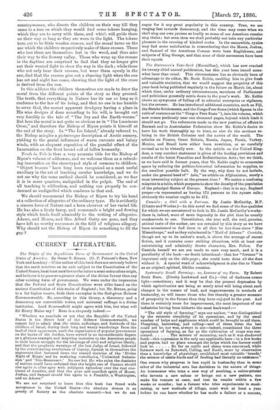THE BISHOP OF RIPON'S ALLEGORIES FOR THE YOUNG.* IT would
not be fair to criticise these gracefully written tales from a merely literary point of view. They were not composed for reading at one's leisure ; they are addresses spoken to a congregation of children, and written out afterwards. They lack, therefore, of necessity some of the literary finish and symmetry which the Bishop of Ripon would doubtless have given them if he had originally intended them for readers instead of hearers. An author is necessarily limited in the
execution of his task by the object at which he aims. In this little book the Bishop of Ripon appears primarily as a preacher, and only accidentally, as it were, in the character of an author ; and what would have been a merit in the author would have been a defect in the preacher. This is, of course, more especially the case when the hearers are young. They may be so interested in the incidents of the story as to miss the special point which the preacher wishes to drive home, and which might easily have been seized, even by young minds, in the leisurely reading of a book. The Bishop of Ripon has there- fore pointed the moral of each tale, sometimes only in a few barbed sentences ; but occasionally, as iu " The Ice Island," the interpretation and the allegory are seen woven together all through the story. The stories are not allegories pure and simple, nor sermonettes interspersed with tales. The substratum of each address is a simple parable from Nature, with occasionally the intervention of a visitant from the spiritual realm. Let us take the pretty allegory of "The Luminous Cross" as an illustration of the Bishop's method.
It represents some children playing in summer weather in a garden among flowers, which are withered by the rays of a scorching sun and the handling of the admiring children. The children mourn over the premature decay of the flowers, their beauty perishing from the very warmth of the love bestowed upon it. The evanescence of earth's fairest gifts is brought vividly before the minds of the children, and they yearn for a land where the flowers will ever bloom, and may be handled without being hurt. Thus reflecting and dreaming, the children retire into an arbour, and see in vision an angel who tells them that over the hills which bound their horizon there is a land where flowers grow which never fade. But how are the children to find their way thither ? The difficulty is solved by the angel, no longer with the traditional wings, but in the garb of a
• Truth in Tale : Addresses chiefly to Children. By W. Boyd Carpenter, D.D., Lord Bishop of Ripon, London : Raemills.n and Co. 1885. countrywoman, who directs the children on their way till they came to a tree on which they would find some tokens hanging, which they are to carry with them, and which will guide them on their way so long as they are worn in the light. The tokens turn out to be little wooden crosses, and the moral turns on the use which the children respectively make of these crosses. Those who lose them are themselves lost in the wood, and thus miss their way to the flowery valley. Those who wrap up the crosses in the daytime are surprised to find that they no longer give out their wonted light to show the way in the dark ; while those who not only bear their crosses, but wear them openly in the sun, find that the crosses give out a cheering light when the sun has set and night has come, showing that the light of the cross is derived from the sun.
In this address the children themselves are made to draw the moral from the different points of the story as they proceed. The truth, that everything in Nature has its use so long as it conforms to the law of its being, and that no one is too humble to serve God, the merest apparent drudgery having a place in His wise designs if done according to his will, is brought out very forcibly in the tale of " The Ivy and the Earth-worms." But here the moral is not quite so obvious as in "The Luminous Cross," and therefore the Bishop of Ripon points it himself at the end of the story. In "The Ice Island," already referred to, the Bishop mingles a picturesque description of Arctic scenery, yielding to the genial influences of warm currents and balmy winds, with an eloquent exposition of the parallel effect of the Incarnation on the frost bound soil of fallen humanity.
Truth in Tale is thus a very accurate title for the Bishop of Ripon's volume of addresses, and we welcome them as a refresh- ing innovation on the stereotyped style of sermons to children. " Object lessons " have long been recognised as a most useful auxiliary in the art of teaching secular knowledge, and we do not see why the same method should be considered, as we fear it is in some quarters, undignified in the pulpit. The end of all teaching is edification, and nothing can properly be con- demned as undignified which conduces to that end.
We should recommend the Bishop of Ripon to try his hand at a collection of allegories of the ordinary type. He is evidently a sincere lover of Nature and a keen observer of her varied life. He has also a lively fancy, and commands a bright and flowing style which lends itself admirably to the writing of allegories. Adams, and Monro, and Mrs. Alfred Gatty are gone, and they have left no worthy successors in the field of religious allegory. Why should not the Bishop of Ripon do something to fill the gap ?



































 Previous page
Previous page